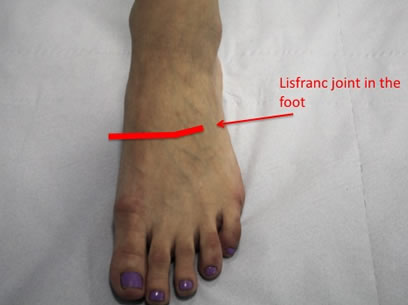in Foot and Ankle Surgery and Reconstruction

A LisFranc fracture is a fracture or dislocation in the Lisfranc joints. It is so-called because Jacques Lisfranc de St Martin, a French surgeon during the Napelonic wars, originally described a wartime amputation through this part of the foot. Thankfully the modern Lisfranc fracture is nothing to do with an amputation!
Virtually any mechanism can lead to this fracture. They are increasingly seen in athletes with forced twisting or crush injuries but can even occur from a simple stumble on uneven ground or slip of a step. They can occur due to crush injury on the foot or trapping part of the foot while the rest of the foot twists.
Pain is usually fairly significant. The middle of the foot can swell quite dramatically. It is usually very uncomfortable to walk on the foot. Bruising can become rapidly apparent on the foot.
If in doubt as to whether you have this injury you are advised to keep your foot elevated and avoid walking on it if possible. Referral for urgent and accurate clinical assessment with an X-Ray is important.
An accurate clinical assessment by an Orthopaedic foot and ankle surgeon is vital. An X-Ray of the foot is also mandatory. Often a CT (computerised tomography) is done also to further assess the fracture or injury pattern.
Operative treatment fixing with plates or screws on the top of the foot is usually advocated for more severe or unstable injuries, where the bones have moved apart form their normal position at the level of the Lisfranc joint. If the bones heal in the wrong position chronic foot pain and arthritis at the Lisfranc joint can be a future problem. In the less severe or stable fractures, where on scans the bones are in their normal anatomical positions, they can be treated non-operatively with non-weight bearing in a plaster or boot for about 6 weeks. Long-term insoles, especially in sports can be worn to good effect after initial treatment.
Initial plaster casting is worn for 6 weeks and then depending on the severity of injury a boot may be required for a further 6 weeks. Return to full activity can take over 5 months, whether an amateur or a professional athlete.
Many heal uneventfully. The metalwork can be prominent on the foot and removed, in fact many surgeons take the metal out as routine after 4 months. In severe injuries unfortunately the damage can lead to wear and tear in the joints even after surgery. Further surgery can be successful in eradicating the arthritic pain by fusing the joints with a MIDFOOT FUSION.